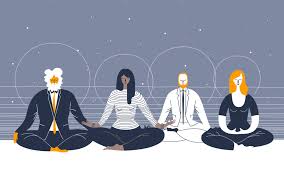
By Katelyn Johnson, CVC volunteer
- Take your seat. Whatever you’re sitting on — a chair, a meditation cushion, a park bench —find a spot that gives you a stable, solid seat.
- Notice what your legs are doing. If you’re on a cushion on the floor, cross your legs comfortably in front of you. (If you already know some kind of seated yoga posture, go ahead.) If you’re on a chair, it’s good if the bottoms of your feet are touching the floor.
- Straighten, but don’t stiffen, your upper body. The spine has natural curvature. Let it be there. Your head and shoulders can comfortably rest on top of your vertebrae.
- Situate your upper arms parallel to your upper body. Then let your hands drop onto the tops of your legs. With your upper arms at your sides, your hands will land in the right spot. Too far forward will make you hunch. Too far back will make you stiff. You’re tuning the strings of your body – not too tight and not too loose.
- Drop your chin a little, and let your gaze fall gently downward. You may let your eyelids lower. If you feel the need, you may lower them completely, but it’s not necessary to close your eyes when meditating. You can simply let what appears before your eyes be there without focusing on it.
- Be there for a few moments. Relax. Bring your attention to your breath or the sensations in your body.
- Feel your breath – or some say “follow” it – as it goes out and as it goes in. Some versions of this practice put more emphasis on the outbreath, and for the inbreath you simply leave a spacious pause. Either way, draw your attention to the physical sensation of breathing: the air moving through your nose or mouth, the rising and falling of your belly or your chest. Choose your focal point, and with each breath, you can mentally note “breathing in” and “breathing out.”
- Inevitably, your attention will leave the breath and wander to other places. Don’t worry. There’s no need to block or eliminate thinking. When you get around to noticing your mind wandering – in a few seconds, a minute, five minutes – just gently return your attention to the breath.
- Practice pausing before making any physical adjustments (such as moving your body or scratching an itch). With intention, shift at a moment you choose, allowing space between what you experience and what you choose to do.
- You may find your mind wandering constantly. That’s normal, too. Instead of wrestling with or engaging with those thoughts as much, practice observing without needing to react. Just sit and pay attention. As hard as it is to maintain, that’s all there is. Come back over and over again without judgment or expectation.
- When you’re ready, gently lift your gaze (if your eyes are closed, open them). Take a moment and notice any sounds in the environment. Notice how your body feels right now. Notice your thoughts and emotions. Pausing for a moment, decide how you’d like to continue on with your day.


